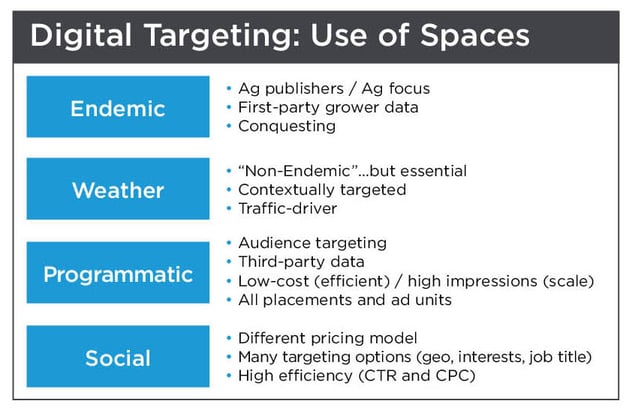Keeping radio relevant in the media mix
Radio is the one medium that has stood the test of time, ...

As farmers make greater use of digital tools and information, the options to bolster your overall agriculture advertising strategy continue to grow. And the options grow more complicated.
Earlier this year, we considered the differences between endemic and programmatic advertising as the rise of Big Data opened the door to new ways to reach the multifaceted farmer. In this post, we expand on this toolkit to explore four categories of targeting and how they vary by channel.
Within the current set of digital spaces and channels useful to Ag marketers, there are best practices to keep in mind for finding your specific farming segment.
We classify websites or networks from Ag publishers (or those with a clear Ag focus) as “endemic.”
When advertising with these partners, you may have the option to leverage their first-party data about their audiences to target farmers both on and off their sites. Targeting via publisher data can yield a highly qualified audience with more engagement.
Endemic advertising enables us to narrow in on our desired audience for specific brands by adding demographic targeting by crop or acreage. Geotargeting is also available, sometimes with a slight premium, and should be used when the brand or message calls for it.
Targeting by brand (also called conquesting) is available through some large sites and publishers; it can be worth a test when the marketing strategy aligns with that approach.
There is a small set of big weather sites that are great for targeting Ag. We put Weather sites into the “Non-Endemic” category, but the truth is, weather sites are an essential tool accessed by farmers multiple times a day. They are contextually relevant and efficient traffic drivers via mobile and desktop devices.
Programmatic companies end up sending a lot of ads to weather sites for farmer-targeting campaigns, but we usually buy advertising on weather sites directly. They, in turn, can target the grower audience via third-party data combined with additional geo-targeting layered in by crop.
All of our programmatic partners build audiences via data platforms such as those offered by Oracle (BlueKai) or Adobe (Audience Manager). This allows targeting of grower segments while accessing programmatic inventory. These segments are generated through combinations of behavioral modeling, purchase data, search keywords, and more.
Among partners Rhea+Kaiser has worked with, some utilize an additional audience qualifier leveraging the North American Industry Classification System (NAICS) to identify farming operations. Others utilize an additional layer of contextual targeting.
With programmatic partners potentially targeting the same audiences, it’s important to make sure that there is a unique tactical need for using each partner, avoiding overlap. To this end, we may use a specific partner in a digital campaign for video, another for display, and others for retargeting or native.
Given the scale and reach of social media, it should surprise no one that enough farmers use social media regularly that it is worth a look – and usually an investment – for farmer-targeted campaigns.
The key is to prioritize the targeting you need for any particular campaign.
Farmers can be effectively reached on Facebook by:
On Twitter, Farmers can also be identified based on ag industry hashtags they are following or by industry keywords they have searched for.
Certain exclusions can be essential on both Facebook and Twitter. It may be appropriate to negatively target some subjects. This ensures that certain audiences prone to react negatively to some Ag messaging do not receive the ads.

The wide variety of digital channels and targeting methods for reaching farmers is a great development for Ag marketers. But it requires a thoughtful and deliberate approach to ensure that you finding your precise segment of the Ag industry.
Keeping radio relevant in the media mix
Radio is the one medium that has stood the test of time, ...
© 2024 Rhea + Kaiser. All rights reserved.